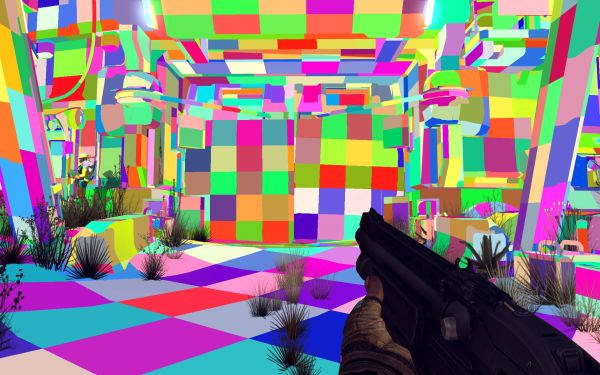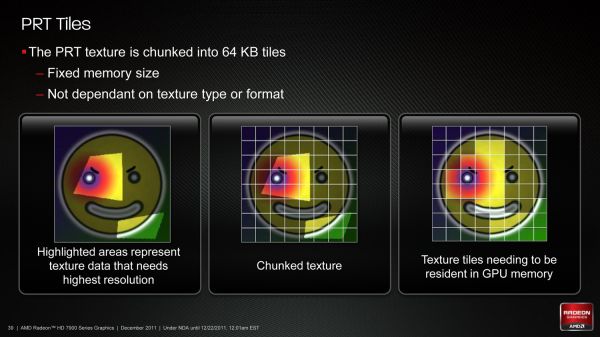AMD Radeon HD 7970 Review: 28nm And Graphics Core Next, Together As One
by Ryan Smith on December 22, 2011 12:00 AM EST- Posted in
- GPUs
- AMD
- Radeon
- ATI
- Radeon HD 7000
Partially Resident Textures: Not Your Father’s Megatexture
John Carmack’s id Software may not be the engine licensing powerhouse it was back in the Quake 3 days, but that hasn’t changed the revolutionary nature of his engine designs. The reason we bring this up is because there’s a great deal of GPU technology that can be directly mapped to concepts Carmack first implemented. For id Tech 4 Carmack implemented shadow volume technology, which was then first implemented in hardware by NVIDIA as their UltraShadow technology, and has since then been implemented in a number of GPUs. For id Tech 5 the trend has continued, now with AMD doing a hardware implementation of a Carmack inspired technology.
Among the features added to Graphics Core Next that were explicitly for gaming, the final feature was Partially Resident Textures, which many of you are probably more familiar with in concept as Carmack’s MegaTexture technology. The concept behind PRT/Megatexture is that rather than being treated as singular entities, due to their size textures should be broken down into smaller tiles, and then the tiles can be used as necessary. If a complete texture isn’t needed, then rather than loading the entire texture only the relevant tiles can be loaded while the irrelevant tiles can be skipped or loaded at a low quality. Ultimately this technology is designed to improve texture streaming by streaming tiles instead of whole textures, reducing the amount of unnecessary texture data that is streamed.
Currently MegaTexture does this entirely in software using existing OpenGL 3.2 APIs, but AMD believes that more next-generation game engines will use this type of texturing technology. Which makes it something worth targeting, as if they can implement it faster in hardware and get developers to use it, then it will improve game performance on their cards. Again this is similar to volume shadows, where hardware implementations sped up the process.
In order to implement this in hardware AMD has to handle two things: texture conversion, and cache management. With texture conversion, textures need to be read and broken up into tiles; AMD is going with a texture format agnostic method here that can simply chunk textures as they stand, keeping the resulting tiles in the same format. For AMD’s technology each tile will be 64KB, which for an uncompressed 32bit texture would be enough room for a 128 x 128 chunk.
The second aspect of PRT is managing the tiles. In essence PRT reduces local video memory to a very large cache, where tiles are mapped/pinned as necessary and then evicted as per the cache rules, and elsewhere the hardware handles page/tile translation should a tile not already be in the cache. Large tomes have been written on caching methods, and this aspect is of particular interest to AMD because what they learn about caching here they can apply to graphical workloads (i.e. professional) and not just gaming.
To that end AMD put together a technology demo for PRT based on Per-Face Texture Mapping (PTEX), a Disney-developed texture mapping technique that maps textures to polygons in a 1:1 ratio. Disney uses this technique for production rendering, as by constraining textures to a single polygon they don’t have to deal with any complexities that arise as a result of mapping a texture over multiple polygons. In the case of AMD’s demo it not only benefits for the reasons that Disney uses it, but also because when combined with tessellation it trivializes vector displacement, making art generation for tessellated games much easier to create. Finally, PRT fits into all of this by improving the efficiency of accessing and storing the Ptex texture chunks.
Wrapping things up, for the time being while Southern Islands will bring hardware support for PRT software support will remain limited. As D3D is not normally extensible it’s really only possible to easily access the feature from other APIs (e.g. OpenGL), which when it comes to games is going to greatly limit the adoption of the technology. AMD of course is working on the issue, but there are few ways around D3D’s tight restrictions on non-standard features.

















292 Comments
View All Comments
Ananke - Thursday, December 22, 2011 - link
"The 7970 leads the 5870 by 50-60% here and in a number of other games"...and as I see it also carries 500-600% of price premium over the 5870.Meh, this is so so priced for a FireGL card, but very badly placed for a consumer market. Regardless, CUDA is getting more open meanwhile. AMD is still several generations/years behind in the HPC market and marketing a product above the NVidia price targets will not help AMD to make it popular.
Having say so, I am using ATI cards for gaming for several years already, and I am very pleased with their IQ and performance. I have always pre-purchased my ATI cards... What I am missing though is teh promised and never materialized consumer level software that can utilize its calculation ability, aka CyberLink and other video transcoders. If it was not for the naughty Nvidia power draw in the 5th series, I would've gone green to have CUDA. Hence, considering SO MUCH MONEY, I am waiting at least 6 months from now to see what the prices will be for the both new contenders in next GPU architectures :).
Dangerous_Dave - Thursday, December 22, 2011 - link
Seems like AMD can't do anything right these days. Bulldozer was designed for a world that doesn't exist, and now we have this new GPU stinking up the place. I'm sorry but @28nm you have double the transistors per area compared with @40nm, yet the performance is only 30% better for a chip that is virtually the same size! It should be at least twice as far ahead of the 6970 as that, even on immature drivers. As it stands, AMD @ 28nm is only just ahead of Nvidia @ 40nm as far as minimums go (the only thing that matters).I shudder to think how badly AMD is going to get destroyed when Nvidia release their 28nm GPU.
Finally - Friday, December 23, 2011 - link
I shudder to think how badly one Nvidia fanboy's ego is going to get scratched if team red released a better GPU and his favourite team has nothing to offer.Oh... they did?
CeriseCogburn - Thursday, March 8, 2012 - link
We have to let amd "go first" now since they have been so on the brink of bankruptcy collapse for so long that they've had to sell off most of their assets... and refinance by AbuDhabi oil money...I think it's nice our laws and global economy puts pressure on the big winners to not utterly crush the underdogs...
Really, if amd makes another fail it might be the last one before collapse and "restructuring" and frankly not many of us want to see that...
They already made the "last move" a dying company does and slashed with the ax at their people...
If the amd fans didn't constantly demand they be given a few dollars off all the time, amd might not be failing - I mean think about it - a near constant loss, because the excessive demand for price vs perf vs the enemy is all the radeon fans claim to care about.
It would be better for us all if the radeon fans dropped the constant $ complaints and just manned up and supported AMD as real fans, with their pocketbooks... instead of driving their favorite toward bankruptcy and cooked books filled with red ink...
Dangerous_Dave - Thursday, December 22, 2011 - link
On reflection this card is even worse than my initial analysis. For 3.4billion transistors AMD could have done no research at all and simply integrated two 6870s onto a single die (a la 5870 vs 4870) and ramped up the clock speed to somewhere over 1Ghz (since 28nm would have easily allowed that). This would have produced performance similar to a 6990, and far in excess of the 7970.Instead we've done a lot of research and spent 4.1billion transistors creating a card that is far worse than a 6990!
That's the value of AMD's creative thinking.
cknobman - Thursday, December 22, 2011 - link
The sad part is your likely too stupid to realize just how idiotic your post sounds.They introduced a new architecture that facilitates much better compute performance as well as giving more gaming performance.
Did you read the article and look at the compute benchmarks or did you just flip through the game benchmark pages and look at numbers without reading?
Zingam - Thursday, December 22, 2011 - link
Or maybe you just don't realize that they've added another 2 billion transistors for minimal graphics performance increase over the previous generation.That's almost as if you buy a new generation BMW that has instead 300 hp, 600hp but is not able to drag a bigger trailer.
The only benefit for you would be that you can brag that you've just got the most expensive and useless car available.
Finally - Friday, December 23, 2011 - link
Rule 1A:The frequency of a car pseudoanalogy to explain a technical concept increases with thread length. This will make many people chuckle, as computer people are rarely knowledgeable about vehicular mechanics.
cknobman - Friday, December 23, 2011 - link
Holy sh!t are you not reading and understanding the article and posts here??????????The extra transistors and new architecture were to increase COMPUTE PERFORMANCE as well as graphics.
Think bigger picture here dude not just games. Think of fusion and how general computing and graphics computing will merge into one.
This architecture is much bigger than just being a graphics card for games.
This is AMD's fermi except they did it about 100x better than Nvidia keeping power in check and still having amazing performance.
Plus your looking at probably beta drivers (heck maybe alpha) so there could very will be another 10+% increase in performance once this thing hit retail shelves and gets some driver improvements.
CeriseCogburn - Thursday, March 8, 2012 - link
I see. So when nvidia did it, it was abandoning gamers for 6 months of ripping away and gnawing plus... but now, since it's amd, amd has done it 100X better... and no abandonment...Wow.
I love hypocrisy in it's full raw and massive form - it's an absolute wonder to behold.